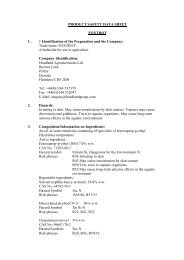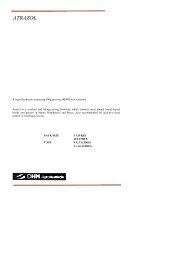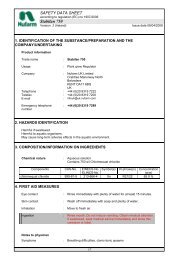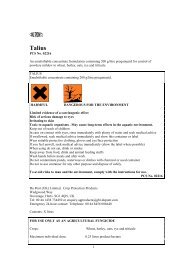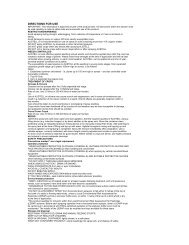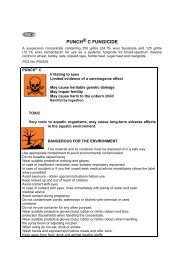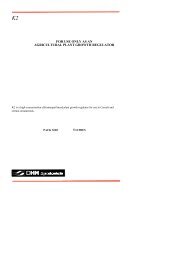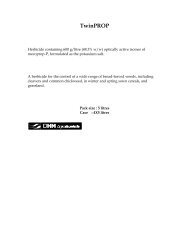You also want an ePaper? Increase the reach of your titles
YUMPU automatically turns print PDFs into web optimized ePapers that Google loves.
Q-CHEM<br />
Q-CHEM nv<br />
Leeuwerweg 138 • B-3803 Sint-Truiden • BELGIUM<br />
Tel. +32 (0)11 78 57 17 • Fax +32 (0)11 68 15 65<br />
Mobile +32 (0)474 95 13 91 • E-mail: q-chem@skynet.be<br />
BTW/VAT: BE 865.950.672 • BIC: KREDBEBB<br />
Bank: KBC 733-0209642-55 • IBAN: BE31 7330 2096 4255<br />
APPLICATION FOR APPROVAL<br />
Product: QUAD<br />
QUAD<br />
For desiccation of potato haulm, oilseed rape, laid barley and oats for animal feed,<br />
combining peas harvested dry, f<strong>ie</strong>ld beans for animal feed, red and white clover for<br />
seed and linseed. Weed control in row crops<br />
A soluble liquid containing 200 g/litre (16.7% w/w) diquat present as 374 g/L diquat dibromide<br />
CROP<br />
IMPORTANT INFORMATION<br />
FOR USE ONLY AS AN AGRICULTURAL/HORTICULTURAL HERBICIDE/DESICCANT<br />
Max.<br />
individual<br />
dose (L/ ha)<br />
Max. total<br />
dose<br />
(L/ha/crop)<br />
Max. number of<br />
treatments<br />
(per crop)<br />
Latest time<br />
of<br />
application<br />
Potato<br />
weed control<br />
2 - 1<br />
-<br />
desiccant 4 4 -<br />
Oilseed rape<br />
Combining Pea<br />
(dry harvested)<br />
Dr<strong>ie</strong>d broad bean<br />
F<strong>ie</strong>ld bean (animal feed)<br />
3 - 1 -<br />
Red clover (seed crop)<br />
White clover (seed crop)<br />
Linseed<br />
Barley (animal feed)<br />
Oats (animal feed)<br />
4 - 1 -<br />
Ornamental plant production<br />
Sugar beet<br />
2 - 1<br />
Before<br />
transplanting<br />
or before crop<br />
emergence<br />
All edible crops (around)<br />
All non edible crops (around) 2 - - -<br />
Other Specific restrictions:<br />
This product must not be appl<strong>ie</strong>d through ultra low volume equipment (ULVA) or mistblower<br />
equipment.<br />
READ THE LABEL BEFORE USE. USING THIS PRODUCT IN A MANNER THAT IS<br />
INCONSISTENT WITH THE LABEL MAY BE AN OFFENCE. FOLLOW THE CODE OF<br />
PRACTICE FOR USING PLANT PROTECTION PRODUCTS.<br />
IMPORTANT: The (COSHH) Control of Substances Hazardous to Health Regulations may<br />
apply to the use of this product at work (UK only).<br />
PROTECT FROM FROST<br />
For Professional Use Only<br />
QUAD: Approved Label 08/03/2007 Page 1
Q-CHEM<br />
Q-CHEM NV<br />
Leeuwerweg 138 - B-3803 Sint-Truiden - Belgium<br />
Tel: +32 (0)11 78 57 17 - Fax: +32 (0)11 68 15 65<br />
E-mail: q-chem@skynet.be<br />
Contents:<br />
10 litres ℮<br />
Batch No: see bottle<br />
T<br />
TOXIC<br />
N<br />
DANGEROUS FOR THE<br />
ENVIRONMENT<br />
Health and Safety Information<br />
R22: Harmful if swallowed.<br />
R23: Toxic by inhalation<br />
R36/37/38: Irritation to eyes, respiratory system and skin.<br />
R43: May cause sensitization by skin contact.<br />
R48/25: Toxic: danger of serious damage to health by<br />
prolonged exposure if swallowed.<br />
R50/53: Very toxic to aquatic organisms, may cause<br />
long-term adverse effects in the aquatic<br />
environment.<br />
S2: Keep out of reach of children.<br />
S13: When using do not eat, drink or smoke.<br />
S20/21: Keep away from food, drink and animal feeding stuffs.<br />
S25: Avoid contact with eyes.<br />
S28: After contact with skin, wash immediately with water.<br />
S36/37: Wear suitable protective clothing and gloves.<br />
S45: In case of accident or if you feel unwell seek medical<br />
advice immediately (show this label where possible).<br />
S35: This material and its container must be disposed of in a<br />
safe way.<br />
S57: Use appropriate containment to avoid environmental<br />
contamination.<br />
To avoid risks to man and the environment, comply with the<br />
instructions for use.<br />
MAPP 13396 – PCS No. 03180<br />
QUAD: Approved Label 08/03/2007 Page 2
Q-CHEM<br />
SAFETY PRECAUTIONS<br />
OPERATOR PROTECTION<br />
Engineering control of operator exposure must be used where reasonably practicable in<br />
addition to the following personal protective equipment:<br />
WEAR SUITABLE PROTECTIVE CLOTHING (COVERALLS) AND SUITABLE<br />
PROTECTIVE GLOVES when handling the concentrate and when handling<br />
contaminated surfaces.<br />
WEAR SUITABLE PROTECTIVE CLOTHING (COVERALLS) AND SUITABLE<br />
PROTECTIVE GLOVES AND RUBBER BOOTS when applying by hand held equipment.<br />
WEAR SUITABLE PROTECTIVE CLOTHING (COVERALLS) when applying by vehicle<br />
mounted equipment.<br />
However, engineering controls may replace personal protective equipment if a COSHH<br />
assessment shows that they provide an equal or higher standard of protection.<br />
TAKE OFF IMMEDIATELY all contaminated clothing.<br />
WASH ALL PROTECTIVE CLOTHING thoroughly after use, especially the insides of gloves.<br />
WASH CONCENTRATE from skin or eyes immediately.<br />
DO NOT BREATHE SPRAY.<br />
WASH HANDS AND EXPOSED SKIN before meals and after work.<br />
ENVIRONMENTAL PROTECTION<br />
HARMFUL TO LIVESTOCK. Keep all livestock out of treated areas for at least 24 hours after<br />
treatment.<br />
Do not contaminate water with the product or its container. Do not clean application<br />
equipment near surface water. Avoid contamination via drains from farmyards and roads.<br />
DO NOT USE STRAW (OR HAULM) FROM TREATED CROPS AS ANIMAL FEED (OR<br />
BEDDING) for at least four days after last application.<br />
STORAGE AND DISPOSAL<br />
KEEP IN ORIGINAL CONTAINER, tightly closed in a safe place.<br />
RINSE CONTAINER THOROUGHLY by using an integrated pressure rinsing device or<br />
manually rinsing three times. Add washings to sprayer at time of filling and dispose of safely.<br />
DO NOT RE-USE CONTAINER FOR ANY PURPOSE.<br />
DIRECTIONS FOR USE<br />
IMPORTANT: This information is approved as part of the product label. All instructions within<br />
this section must be read carefully in order to obtain safe and successful use of this product.<br />
APPROVED USES<br />
QUAD can be used as a ‘harvest aid’ for desiccating a wide range of crops - potatoes,<br />
oilseed rape, laid barley and oats, combining peas for harvesting dry, f<strong>ie</strong>ld beans, linseed,<br />
red and white clover for seed. QUAD can be used for the control of certain broad-leaved<br />
weeds in row crops, e.g. chickweed, cleavers, knotgrass and annual nettle.<br />
QUAD: Approved Label 08/03/2007 Page 3
Q-CHEM<br />
PROPERTIES OF QUAD<br />
QUAD is rainfast 15 minutes after spraying and acts rapidly on the green parts of all plants.<br />
Within a few days of spraying, the green parts of most plants, both crops and weeds are<br />
completely desiccated. QUAD is inactivated by soil and cannot affect further crops. QUAD<br />
may be appl<strong>ie</strong>d through any standard farm sprayer.<br />
RESISTANCE<br />
Diquat belongs to the class of herbicides known as the bipyridyls. Strains of annual meadow<br />
grass and american-willowherb resistant to bipyridyls have been found in some hop<br />
yards/gardens and also top and soft fruit orchards. Where bipyridyl resistant strains are<br />
present QUAD may not give full control of these weeds.<br />
CROP SPECIFIC INFORMATION<br />
POTATO HAULM DESICCATION<br />
Apply when tubers are the desired size.<br />
If tubers are to be stored, leave 14 days after spraying to allow skins to set.<br />
Seed crops: re-growth may occur if desiccated early.<br />
In dry conditions see special note below.<br />
For best results: Spray in bright light and low humidity conditions. The ideal time is midmorning<br />
to mid-afternoon.<br />
Rate of Use<br />
Maximum individual dose: 4 litres per hectare.<br />
Maximum total dose per crop: 4 litres per hectare. QUAD may be appl<strong>ie</strong>d to the potato crop<br />
at 2.0 litres per hectare for weed control (see section on weed control in row crops) and up to<br />
a maximum of 4.0 litres product per hectare for haulm destruction.<br />
Volume of Water<br />
200-500 litres per hectare. Use 500 litres per hectare where haulm is dense.<br />
DO NOT ADD ANY WETTER OR ADJUVANT.<br />
SPECIAL NOTE: Application during or shortly after dry periods.<br />
Haulm destroyers may damage tubers if appl<strong>ie</strong>d during or shortly after dry periods. When<br />
mist, light rain or heavy dew is present or imminent, the risk of such damage is increased. Do<br />
not apply when the soil is dry.<br />
Soil moisture around the tubers should be assessed in the f<strong>ie</strong>ld to ensure that rainfall or<br />
irrigation has penetrated to below tuber depth. It is essential that all parts of the f<strong>ie</strong>ld comply<br />
with this requirement particularly where soils vary within the f<strong>ie</strong>ld.<br />
DESICCATION OF COMBINABLE CROPS BEFORE HARVEST<br />
QUAD will not hasten crop maturity. If used on unripe or uneven seed crops, immature seed<br />
with poor germination and low bushel weight will result.<br />
OILSEED RAPE<br />
Apply when on most plants the seed colour at each of the three sections of the stem is as<br />
follows:<br />
Top third<br />
Middle third<br />
Bottom third<br />
More than half of the seed will be green, firm and pliable with a few early<br />
ripening seeds brown to black in colour.<br />
90% of the seed will be reddish brown to dark brown with a few seeds<br />
black. The remaining 10% will be green but must be firm and pliable.<br />
All the seed will be dark brown to black.<br />
QUAD: Approved Label 08/03/2007 Page 4
Q-CHEM<br />
Note: This is usually 2-3 days later than wind-rowing would normally have started.<br />
In crops which are leaning over, the seeds on the upper side of the stem will mature ahead of<br />
those shaded from the sunlight. In this situation, spray when all the seed in the exposed pods<br />
have turned reddish brown to dark brown. Do not wait for all the seeds in the shaded pods to<br />
reach this stage of maturity.<br />
DO NOT apply when the crop is immature or past the recommended stage of maturity. Crops<br />
at an advanced stage of maturity will have 90% of the seed black in colour and pod shatter<br />
will be evident in early ripening pods at the base and top of main stems.<br />
AVOID desiccation with QUAD on thin, standing rape crops and on exposed sites. Losses<br />
can occur in windy weather between spraying and combining. Normal or heavy leaning crops<br />
do not suffer in this way, such crops are ideal for desiccating with QUAD.<br />
Rate of use<br />
3 litres per hectare in 250-500 litres of water per hectare. Use higher volumes for dense<br />
growth, in particular tall or lodged crops. Add a suitable non-ionic surfactant that is not an<br />
organosilicone in accordance with the manufacturers instructions.<br />
Harvesting<br />
Direct combining can normally begin 7-10 days after spraying. Check the moisture content of<br />
the seed in the standing crop from the fifth day after treatment using a moisture meter<br />
calibrated for oilseed rape. Combine harvesting should commence when the seed is mature,<br />
black in colour and with a moisture level ideally between 12% and 15%. To ensure a sound,<br />
clean sample of seed, the manufacturers’ instructions on setting-up the combine for<br />
harvesting oilseed rape should always be followed.<br />
LAID BARLEY AND OATS (FOR STOCK FEEDING ONLY)<br />
Spray when crop is mature for combining.<br />
Apply 2-4 litres per hectare in 200-500 litres of water per hectare. Use 2 litres for common<br />
chickweed. Use 3 litres for cereal re-growth and broad-leaved weeds. Use 4 litres when<br />
cleaver and common couch are dominant. Add a suitable non-ionic surfactant that is not an<br />
organosilicone in accordance with the manufacturers instructions.<br />
Harvesting<br />
As soon as desiccation is complete, normally 4-7 days. A delay in harvesting may result in<br />
re-growth of grass weeds.<br />
Treated grain and straw may be safely fed to livestock from 4 days after spraying.<br />
TREATED BARLEY AND OATS must be used for stock feed only.<br />
COMBINING PEAS (HARVESTED DRY)<br />
Regular inspection of the crops particularly the bottom of the crop, should be made once it<br />
starts to take on an overall yellow appearance. Spray when the crop is mature i.e.<br />
Top pods: Pods are fleshy, slightly pitted and green or starting to turn<br />
yellow. The seed splits if squeezed.<br />
Middle pods: Pods are pitted and crinkled, yellow and becoming parchmentlike<br />
in texture. The seed is rubbery i.e. can be squeezed<br />
between finger and thumb without splitting.<br />
Bottom pods: Pods are yellow/brown, parchment-like (paper thin). The seeds<br />
are quite hard.<br />
Peas should have moisture content of 45% or less.<br />
Earl<strong>ie</strong>r treatment may result in a proportion of shrivelled peas from immature pods at the tops<br />
of plants, thus lowering y<strong>ie</strong>lds. The crop will take longer to dry out so that some of the<br />
QUAD: Approved Label 08/03/2007 Page 5
Q-CHEM<br />
advantage of desiccation is lost. There is also a risk of collapse of the haulm due to<br />
insuffic<strong>ie</strong>nt lignification of the stems.<br />
If desiccation is left too late the advantage of earliness is lost and there is a danger that<br />
some of the bottom pods will shatter.<br />
Rate of Use<br />
2-3 litres per hectare in 200-500 litres of water per hectare. Use lower rate on less dense<br />
crops with few weeds.<br />
Use of surfactants: Peas for processing for human consumption: consult your processor<br />
before adding surfactants or wetters to QUAD. Where crops are to be used for animal feed<br />
then add a suitable non-ionic surfactant that is not an organosilicone in accordance with the<br />
manufacturers’ instructions.<br />
Harvesting<br />
Direct combining should be carr<strong>ie</strong>d out 7-10 days after application as soon as desiccation is<br />
completed. Treated haulm may be fed to livestock from 4 days after spraying.<br />
FIELD BEANS (FOR PIGEON AND ANIMAL FEED ONLY)<br />
Spray when crop is mature and the majority of pods have turned black, to desiccate haulm<br />
and weeds.<br />
Rate of Use: 3 litres per hectare in 200-500 litres of water per hectare. Add a suitable nonionic<br />
surfactant that is not an organosilicone in accordance with the manufacturers’<br />
instructions.<br />
Harvesting 4-7 days after spraying.<br />
TREATED FIELD BEANS must be used for pigeon and stock feed only.<br />
WHITE AND RED CLOVER FOR SEED<br />
Red and White Clover for direct combining: Spray when the crop is mature, 2-3 days before<br />
expected date of combining. Harvest as soon as desiccation is complete. Delay in combining<br />
may result in regrowth.<br />
White Clover combined direct from swath - spray QUAD 1-2 days before cutting. Harvest<br />
within a few hours of cutting.<br />
Rate of Use<br />
2-3 litres per hectare in 200-500 litres of water per hectare. Use lower rate on less dense<br />
crops. Add a suitable non-ionic surfactant that is not an organosilicone in accordance with<br />
the manufacturers’ instructions.<br />
Clover straw and trash may be fed to livestock from 4 days after spraying.<br />
LINSEED<br />
Spray when the seed is seen to have matured evenly over the whole f<strong>ie</strong>ld. This normally<br />
occurs when the seed capsules are dark brown with the seed inside light brown. The seed<br />
should also rattle in the bolls. Ideally the most mature stems should have started to turn<br />
yellow just below the capsule cluster.<br />
Rate of Use<br />
3 litres per hectare. Add a suitable non-ionic surfactant that is not an organosilicone in<br />
accordance with the manufacturers’ instructions.<br />
Apply through conventional hydraulic f<strong>ie</strong>ld crop spraying equipment with a MEDIUM<br />
QUALITY SPRAY (as defined by the BCPC). Use clean water at a volume of 300 to 500<br />
litres per hectare and a pressure of 2-3 bar. To retain a MEDIUM quality spray with higher<br />
water volumes, the use of twin outlet nozzles or twin spray booms may prove necessary.<br />
QUAD: Approved Label 08/03/2007 Page 6
Q-CHEM<br />
A forward tractor speed of around 8 kph is desirable, coupled with a minimum practical boom<br />
height setting necessary to ensure even crop coverage and penetration to the crop stems.<br />
Harvesting<br />
Direct combining can normally begin 10-20 days after spraying when the seed moisture is<br />
below 14%. Always use a sharp knife on the combine and cut the crop as high as possible -<br />
just below the level of branching of the capsule clusters of the shortest stems. Aim to<br />
combine in bright sunny conditions, or when there is a drying wind.<br />
WEED CONTROL IN ROW CROPS<br />
QUAD may be used in mixtures with GRAMOXONE 100 to give improved control of certain<br />
broad-leaved weeds e.g. common chickweed, cleavers, knotgrass and small nettle.<br />
Timing<br />
Overall spraying:<br />
• Sugar beet, bulbs, vegetable crops: Before crop emergence or transplanting.<br />
Note: On sandy or peat soils allow 3 days between spraying and expected crop emergence<br />
or transplanting.<br />
• Potatoes: Early crops: up to 10% emergence, main crops: up to 40% emergence, provided<br />
no plant is more than 15 cm high. Do not apply after emergence to crops growing from<br />
diseased seed or very small tubers, or under very hot dry conditions.<br />
Inter-row spraying:<br />
Post crop emergence (between the rows of any row crop).<br />
• Use sprayers designed to prevent contamination of the crop foliage by spray.<br />
• Most effective control of weeds is obtained when applications are made at the seedling<br />
stage. Common Fumitory and Knotgrass should be treated at first true leaf stage, Cleavers<br />
when 2 whorls or leaves are present, Wild-oats and volunteer cereals from 2 leaf stage.<br />
Rate of Use<br />
1.5-2 litres per hectare QUAD and 2-3 litres per hectare GRAMOXONE 100.<br />
WHEN USED ON ROW CROPS or between the rows of any row crop, 2-3 litres<br />
GRAMOXONE 100 per hectare must be appl<strong>ie</strong>d in mixture with the product.<br />
Volume of Water<br />
200-500 litres per hectare. Add a suitable non-ionic surfactant that is not an organosilicone in<br />
accordance with the manufacturers’ instructions. Use higher rates if weeds are dense or<br />
beyond the seedling stage.<br />
MIXING AND SPRAYING<br />
Apply through a ground sprayer in good condition. Do not apply through mistblowers. Avoid<br />
Spray Drift: Do not spray in windy conditions.<br />
Fill the spray tank nine tenths full of clean water, then start agitation. Add the recommended<br />
quantity of QUAD to the sprayer using a filling device (e.g. induction hopper), or by direct<br />
addition to the spray tank. Thoroughly rinse empty containers, preferably use an integrated<br />
pressure rinsing device (or manually rinse three times). Add washings to the sprayer at the<br />
time of filling. Top up tank with water to the required volume.<br />
It is essential to spray accurately and to obtain complete cover of crop and weeds:<br />
• Make sure nozzles are in good condition and that sprayer boom is set high enough to<br />
ensure complete coverage.<br />
• Apply by conventional hydraulic sprayer (high clearance if necessary) as a MEDIUM<br />
quality spray (as defined by the BCPC) using a pressure of 2-3 bar. For the higher spray<br />
volumes use twin outlet nozzles or twin spray booms.<br />
• Ensure that the sprayer is correctly calibrated before use.<br />
• Do not leave spray liquid in the sprayer for long periods (i.e. during meals or overnight).<br />
QUAD: Approved Label 08/03/2007 Page 7
Q-CHEM<br />
• Apply application volumes as per individual crop recommendations. Use higher volumes<br />
for dense growth.<br />
SPECIAL NOTE: application during or shortly after dry periods<br />
Damage is most likely to occur if the MORECS (Meteorological Office Rainfall and<br />
Evaporation Calculation System) exceeds 33-83 mm according soil type as in the table<br />
below.<br />
Soil texture* Ware** Early or seed Canning<br />
Sands<br />
Very light soils<br />
Light soils<br />
50 mm 33 mm DO NOT USE<br />
All stony soils (including stony<br />
medium and heavy soils)<br />
Medium soils<br />
Heavy soils<br />
66 mm 60 mm DO NOT USE<br />
(for stony soils see above)<br />
Organic soils (over 10% organic<br />
matter)<br />
Peaty soils<br />
Peats<br />
883 mm 66 mm 50 mm<br />
* As described in RDS Technical Advice Note 52 ‘Soil Texture’<br />
** If the crop is immature or the haulm is very vigorous use the figures in the Early or Seed<br />
column.<br />
NOTES<br />
Before using any tank mixture, consult and comply with the recommendations of the partner<br />
products. Each product should be added separately to the bulk of the water in the spray tank<br />
and thoroughly mixed before adding the next chemical. Always use constant agitation of the<br />
sprayer tank during mixing, transportation and application. Spray immediately.<br />
Always read the label. Use pesticides safely.<br />
QUAD: Approved Label 08/03/2007 Page 8



